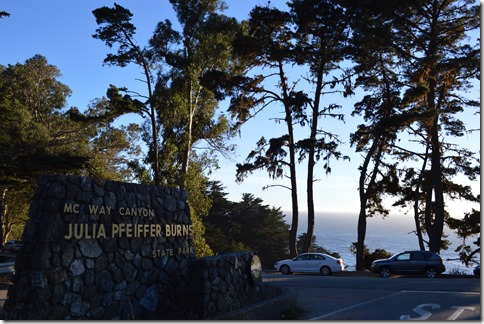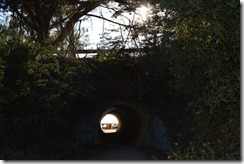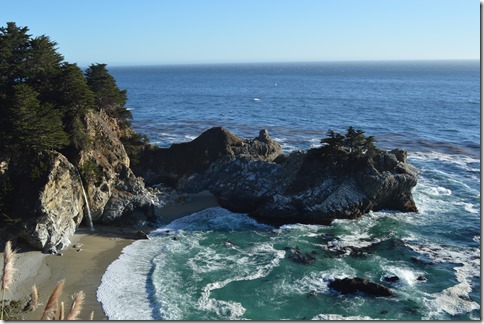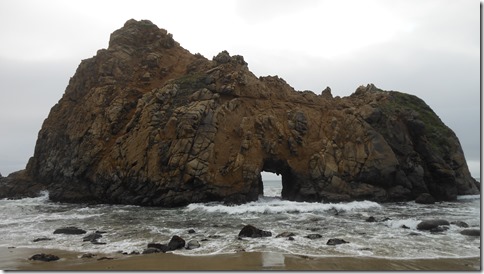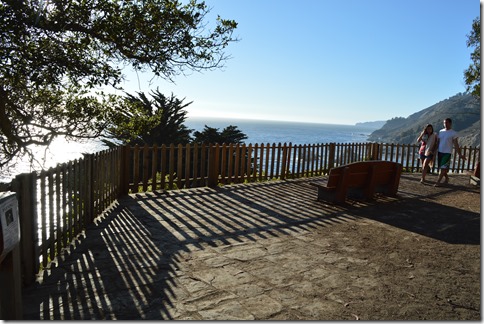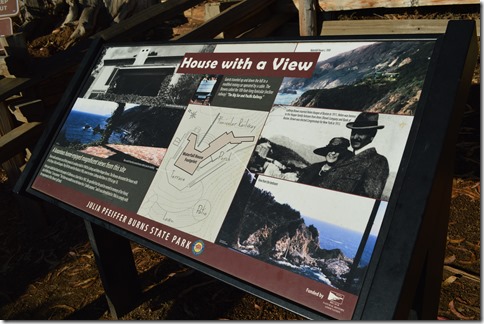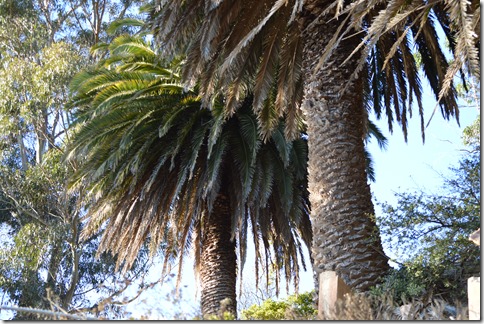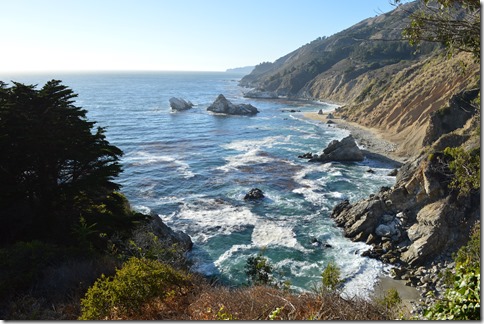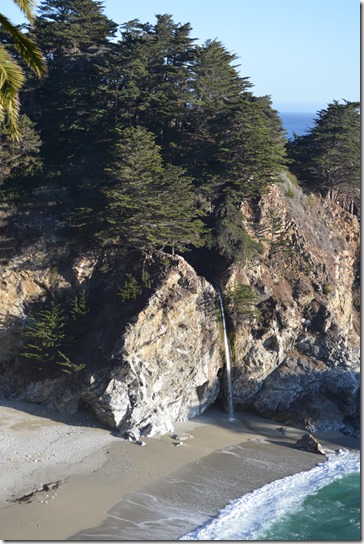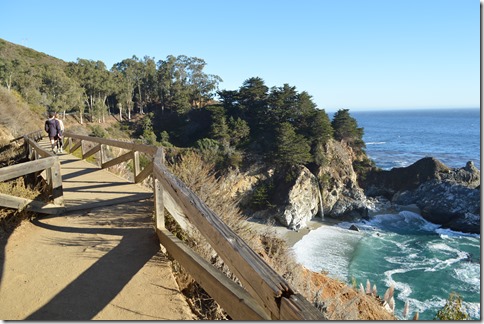McWay Falls at Julia Pfeiffer Burns State Park is a sight to behold. And behold it you can. You can pay $10 to park your car in the State Park or simply park your car on Highway 1, if space is available in this popular tourist destination, and walk into the park to take the trail under Highway 1 for a view of McWay Falls.
There are three stories to tell spanning 100 years at this location to clarify all the names relating to the history of this scenic spot, perhaps the most scenic of all Big Sur locations.
California was officially turned over by the Mexican government to the USA with the Treaty of Guadalupe Hidalgo in 1848 marking an end to the two year long war. Monterey, the capital of Alta California, had been seized by the Americans at the beginning of the war in July 1846.
Owners of California land through Spanish and Mexican grants had to prove in court the land was legally deeded to their families. Many of the great landowners in California without sufficient documentation lost their land and many Mexican landowners went bankrupt pursuing land claims in U.S. courts.
The Homestead Act of 1862 allowed Americans to claim public land and much of the Big Sur wilderness became available for homesteading. California newspaper reports of the Big Sur-Santa Lucia region from the 1850s describe the Santa Lucia coastal mountain range as a great unmapped wilderness. Grizzly bears were still prevalent in these parts. California grizzly bears became extinct in the 1920s.
McWay Canyon
McWay Canyon is named after the original homesteader for this canyon in Big Sur. Christopher McWay homesteaded the canyon in 1887. The homestead barn from 1894 is still standing in Julia Pfeiffer Burns State Park.
The pathway to McWay Falls is through the park on the east side of Highway 1 via a tunnel under Highway 1.
McWay Falls are the only falls on the Big Sur coast dropping to the sea.
McWay Falls at Julia Pfeiffer Burns State Park, Big Sur, California
Julia Pfeiffer Burns
The second name in this story of McWay Falls and Julia Pfeiffer Burns State Park is Julia Pfeiffer.
Michael and Barbara Pfeiffer were traveling the Big Sur coast in 1869 with their 11-month old daughter Julia. They were forced to winter in Big Sur and decided to remain. The Pfeiffer’s settled in Sycamore Canyon.
These days Sycamore Canyon Road, on the west side of Highway 1, about 10 miles north of Julia Pfeiffer Burns State Park or 0.25 miles south of Big Sur Ranger Station, leads to Pfeiffer Beach, the most accessible beach access along the Big Sur coast with camping sites too. Sycamore Canyon Road is hard to spot. If you are driving south and reach Ventana Inn, then you have just missed the road.
Pfeiffer Beach on a foggy day, April 2013.
Julia Pfeiffer helped her father raise cattle on the ranch and remained unmarried until her mid-forties when in 1915 she wed John Burns, another homesteader. They leased a ranch at Burns Creek and ran cattle at McWay’s Saddle Rock Ranch.
Cattle still graze along the beach in a river valley just north of Point Sur. There are about a dozen cattle in the far left of this photo.
Julia also rented the Hot Springs where she ran a lodge and prepared meals in a location four miles south of McWay Canyon, Julia Pfeiffer Burns State Park, now known as Esalen Institute.
Lathrop and Helen Hooper Brown
The third set of names in this story are Lathrop and Helen Hooper Brown. The Brown’s were both East Coast socialites of the gilded age and established millionaires when they were children. Not your typical homesteaders.
The Brown’s purchased Saddle Rock Ranch in 1922 which is now Julia Pfeiffer Burns State Park. The Brown’s built a redwood cabin looking across the cliffs to McWay Falls. In 1940 they constructed ‘Waterfall House’, a mansion by the sea in remote Big Sur.
Pelton Wheel at McWay Canyon provided the first electricity to Big Sur in 1932. Hans Ewoldsen, foreman of the Saddle Rock Ranch, built the Pelton Wheel from redwood and other materials using the machine shop of the construction crews building the Big Sur coast bridges and Highway 1 road. The paddle wheel ran a 32-volt generator sufficient for electric light and appliances at three homes of the Saddle Rock Ranch.
The electricity also ran a funicular railway car to shuttle passengers from the hillside to the house.
The Pelton Wheel house is on a short side path along the McWay Falls 0.25 mile path.
Lathrop Brown had been a close schoolmate of Franklin Delano Roosevelt at Groton and his Harvard roommate and was best man for FDR’s wedding to Eleanor. FDR was best man for Lathrop’s wedding to Helen Hooper in 1911. Lathrop Brown was elected to one term in Congress as Representative for New York’s Long Island District in 1913.
Helen Chamblet Hooper inherited a $10 million estate when she was orphaned at the age of 15, around 1906-07. Her fortune came from family interests in shovels, railroads and banks.
[Note: With limited research I pieced together this story about the Ames family. I do not know Helen Chamblet Hooper’s relationship to the Ames Brothers of the shovel and railroad fortunes. This is just an interesting side tale about how 19th century wealth was made in the USA gilded age and apparently Helen Hooper Brown inherited part of this fortune a couple of generations later.]
Helen Chamblet Hooper was a descendant of the Ames family, a prominent Massachusetts family who originally made their fortune manufacturing Ames shovels starting in 1774. The grandsons took over the Ames Shovel Business in 1844 and renamed it Oliver Ames & Sons. The Gold Rush in California, followed by the Civil War in the 1860s made the Ames brothers wealthy. Oakes Ames was a member of Congress representing Massachusetts from 1863 to 1873. During this time Oakes Ames became the driving force for building the transcontinental railroad from the east and his brother Oliver Ames, Jr. was president of Union Pacific Railroad at the time the Golden Spike was laid linking the eastern railroad to the western railroad owned by magnates like Leland Stanford. The Ames family profited from railroad land and stock interests and the story includes a major Congressional Credit Mobilier scandal of graft when legislators were sold railroad stock at below market prices.
The orphaned heiress Helen Chamblet Hooper married Lathrop Brown in April 1911 at about the age of 20. Lathrop Brown was from a New York real estate family. Helen and Lathrop Brown had loads of money and built many homes including a large estate on Long Island where they could raise horses.
Today at McWay Falls viewpoint in Julia Pfeiffer Burns State Park, there is a public walkway and terrace remaining for the people’s view where there was once a private mansion with a bedroom view of the waterfall.
The Brown’s Waterfall House in the 1940s was decorated with fine art by Gauguin and Degas. The multi-story house had a marble staircase and fine furnishings.
During WWII a second house was built three miles inland on the ridge to be located above the summer fog. ‘Tin House’ was built from recycled gas stations with material salvaged locally when there were shortages of building materials. Limited availability of gas with rationing due to the war resulted in gas stations on the remote Big Sur coast going under financially. The Brown’s built a road, hired an architect and had a multiple room home built from recycled gas station materials. One story told is Helen Brown spent one night in the Tin House and the noise of the cooling contracting metal after a hot day of sun kept her from sleeping in the house again. The Brown’s eventually moved to Florida in 1956 and never returned to Big Sur.
Tin House is still accessible from a hiking trail in the park, however the structure burned in the 2008 Basin Fire Complex..
After Lathrop Brown died in Florida in 1959, Helen Hooper Brown deeded the 1,600 acres of coastal land to the State of California in 1961 with the stipulation the park be named after her friend Julia Pfeiffer Burns and that the house be turned into a museum within five years to house Big Sur history with a collection of Indian and pioneer artifacts of the region. The state did not meet the deadline and the mansion was demolished in 1966 leaving only the stone foundation and large palm trees seen today.
Foundation of Waterfall House today.
Palm trees are suitable for the Mediterranean climate of the Big Sur coast, but not a native species to this region of California. Apparently there has been discussion on removing the trees from the park.
The palm trees are a clue that you are at a California mansion. The Brown story of the former cliff top estate with a bedroom waterfall view explains why there are a row of palm trees out here in the middle of the Big Sur wilderness.
Looking north from the Waterfall House terrace. The winter storms of 1982-83, the largest rainfall since records were kept in California, wreaked destruction across the state. An immense landslide, visible in the sandy soil along the coastline in the photo above also changed the appearance of the cove at McWay Falls. Highway 1 was closed for one year while the road was rebuilt.
McWay Falls plunges 80 feet to the sea at Julia Pfeiffer Burns State Park.
McWay Falls Path at Julia Pfeiffer Burns State Park, Big Sur, California
This article is another in a series I am writing about the Big Sur region of California. I am kind of in a ‘better know my local region’ mindset and Big Sur has been a major attraction to me over the past couple of weeks.
Big Sur has attracted people from around the world for more than 100 years as a place of natural beauty and soul fulfillment. I have been tapping into that energy lately.
Here are some of the resources I used to write this article:
Waterfall Trail in Big Sur, Julia Pfeiffer Burns State Park, Lathrop Brown, Helen Hooper Brown, Waterfall Home, Tin House on Partington, Ewoldson – Anne Canright – PelicanNetwork.net
PelicanNetwrk.net is a major source of local information about Big Sur and the Central Coast region.
About us
For ten yearsPelicanNetwork has been the leading volunteer organization teaching nature conservation and cultural history on California’s Central Coast. More than 5,000 individuals, families and other conservation minded organizations belong. They all share information about protecting our environment and appreciating our history. See more at PelicanNetwork
FDR Suite Restoration Project @Adams House is a website about the rooms where U.S. President Franklin Delano Roosevelt and Lathrop Brown lived while attending Harvard University. There are several articles on this site describing Lathrop Brown’s close relationship to FDR.
- Lathrop Brown and FDR: The Groton Years
- Lathrop Brown and FDR: The Harvard Years
- Lathrop Brown, Political Dilettante
- Lathrop Brown and FDR: Endgame (This article states Lathrop Brown died in 1959 from a ruptured gall bladder. “Energetic to the end, he and Helen were in the middle of yet another amazing house project – the renovation of the paddle steamer Algiers into a winter home at Sanibel Island Florida – when he was stricken with a ruptured gall bladder and died. Helen, or Hélène as she preferred to be known, traveled extensively after Lathrop’s death, living in Bermuda, Tahiti and Hawaii. She became a recluse in her later years and died in 1978.)“
- Lathrop Brown and FDR: Epilogue – this article tells the author’s discovery after working on the FDR Suite Restoration Project @Adams House that Lathrop and Helen Brown were the people who had built and lived in the house that once stood on the cliffs at Julia Pfeiffer Burns State Park with the view of McWay Falls.
St. James Country House built for Lathrop and Helen Brown on Long Island is now part of Knox School. The Brown’s never lived in the estate.
Ames Shovel Company (Wikipedia), Easton, Massachusetts ceased operation in 1952.
PBS American Experience – Transcontinental Railroad – Oakes Ames (1804-1873) biography and Credit Mobilier railroad stocks Congressional scandal.
The Tin House – The California Report June 2012.
Helen Hooper Brown had donated the real property to the State of California in 1962. The deed was recorded the same year. Paragraph 1 of the deed provides: “Said real property shall be used in perpetuity as a public park and for all lawful uses incidental thereto, except those uses, whether or not incidental thereto, which are expressly prohibited by the terms, covenants and conditions hereinafter set forth.”
Many of the facts in this article are from the sign displays at McWay Falls viewpoint.
Ric Garrido, writer and owner of Loyalty Traveler, shares news and views on hotels, hotel loyalty programs and vacation destinations for frequent guests. Check out my page of collated current hotel promotions.
Follow Loyalty Traveler on Twitter and Facebook and RSS feed or subscribe to a daily email newsletter on the upper left side of this page.


